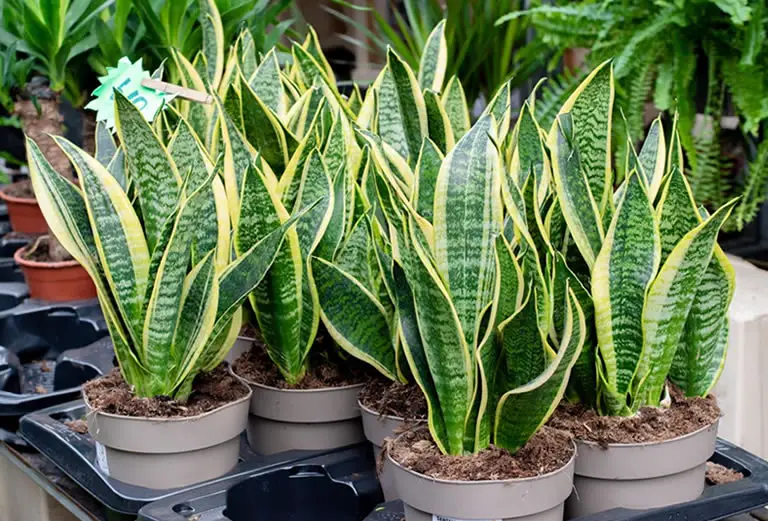Snake plants (Sansevieria) are pretty low-maintenance, making them a great choice for indoor plants. These succulents, once their initial needs are met, are very easy to care for.
Below I have included the 8 simple steps you need to take to ensure your snake plant thrives for many years.
Table of Contents
- 8 Snake Plant Care Essentials
8 Snake Plant Care Essentials
Although snake plants are easy-care succulents I have listed the 8 main essential care requirements this plant needs if you intend to grow it indoors as a houseplant.
Don’t worry, each one is simple and in most cases requires you to follow the initial care step only once (for example, ensuring your plant is placed in the correct permanent location will ensure the temperature is always correct as well as the lighting).
Here are the basic care requirements for keeping your snake plant healthy:
- Light: Snake plants thrive in bright, indirect light but can tolerate low light conditions as well. They’re quite adaptable.
- Watering: They’re drought-tolerant, so water them only when the soil is dry. Overwatering is a common mistake, so make sure the pot has good drainage.
- Temperature: Snake plants prefer warmer temperatures, ideally between 60-85°F (16-29°C). Avoid placing them in cold drafts or areas with temperatures below 50°F (10°C).
- Soil: Use well-draining soil, such as a cactus or succulent mix, to avoid water retention that could lead to root rot.
- Humidity: Snake plants don’t require high humidity, and they do well in average household humidity levels.
- Fertilizing: Feed your plant once a month during the growing season (spring and summer) with a diluted, balanced liquid fertilizer. They don’t need much feeding in the fall and winter.
- Potting: Repot the plant every 1-2 years or when it outgrows its container. Make sure the new pot has drainage holes.
- Cleaning: Wipe the leaves occasionally to remove dust and help them absorb more light.
Snake plants are pretty forgiving, so they’re great for beginners!
Optimal Lighting Conditions
Snake plants, scientifically known as Dracaena trifasciata, are celebrated for their resilience and adaptability, making them a favorite among indoor plant enthusiasts.
One of their most commendable traits is their ability to thrive in a variety of lighting conditions.
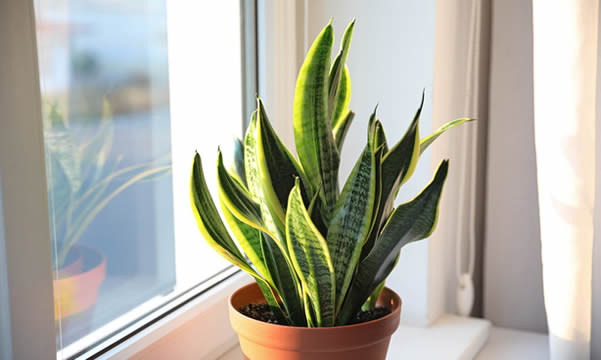
While snake plants are tolerant of low light, they flourish best in bright, indirect light.
Placing them near east or west-facing windows allows them to receive ample light without the risk of leaf scorch.
Direct sunlight, especially from southern exposures, can be too intense and may lead to leaf burn.
Adaptability to Low Light
One of the remarkable features of snake plants is their adaptability to low-light environments.
They can survive in dimly lit rooms, making them suitable for spaces with limited natural light.
However, it’s important to note that while they can survive in low light, their growth may slow down, and they might produce fewer new leaves compared to those placed in brighter conditions.
Artificial Lighting Solutions
For areas lacking sufficient natural light, snake plants can benefit from artificial lighting.
Using fluorescent or LED grow lights can supplement their light needs.
Positioning the plant under these lights for about 12-14 hours a day can mimic natural daylight, promoting healthier growth.
Signs of Light Stress
It’s essential to monitor your snake plant for signs of light-related stress.
If the leaves develop brown tips or edges, it might indicate exposure to too much direct sunlight.
Conversely, if the plant becomes leggy with elongated stems and sparse leaves, it could be a sign of insufficient light.
In summary, while snake plants are versatile and can adapt to various lighting conditions, providing them with bright, indirect light will ensure they thrive and maintain their vibrant appearance.
Snake plants (Dracaena trifasciata) are renowned for their hardiness and minimal care requirements, making them a favorite among both novice and seasoned plant enthusiasts. One of the most crucial aspects of their care is proper watering.
Understanding Watering Needs
Snake plants are succulents, meaning they have the ability to store water in their thick, fleshy leaves.
This adaptation allows them to withstand periods of drought. However, this also means that overwatering is a common mistake that can lead to root rot.
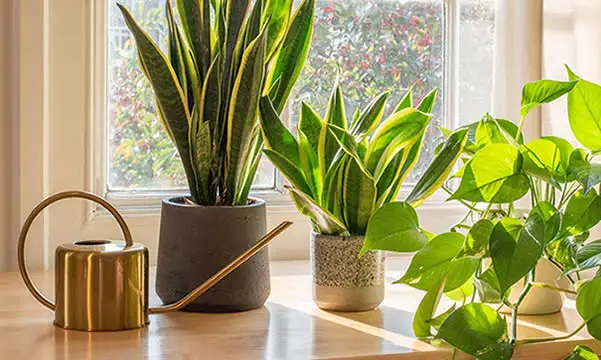
To ensure your snake plant thrives, it’s essential to allow the soil to dry out completely between waterings.
A good rule of thumb is to water once every two weeks during the growing season and less frequently in winter.
Signs of Overwatering and Underwatering
Recognizing the signs of overwatering and underwatering can help you adjust your care routine accordingly.
Overwatered snake plants may exhibit yellowing leaves, mushy stems, and waterlogged soil.
If you notice these symptoms, it’s advisable to unpot the plant, check the roots for rot, and repot it in fresh, well-draining soil.
On the other hand, underwatered snake plants might display brown, crispy leaf tips, dying leaves, and hard, compacted soil that pulls away from the pot’s edge.
If you observe these signs, a thorough watering should help revitalize your plant.
Watering Techniques
When it’s time to water, ensure that the pot has drainage holes to prevent water from accumulating at the roots.
Water the plant deeply, allowing the moisture to reach the root zone.
After watering, empty any excess water from the saucer to prevent the plant from sitting in stagnant water, which can lead to root rot.
In summary, while snake plants are forgiving and can tolerate some neglect, adhering to a proper watering schedule is vital for their health.
By allowing the soil to dry out between waterings and being attentive to the plant’s signs, you can ensure your snake plant remains a vibrant and resilient addition to your home.
Snake plants (Dracaena trifasciata) are celebrated for their hardiness and adaptability, making them a favorite among indoor plant enthusiasts.
For a more in-depth guide read our article that reveals snake plant watering secrets.
Temperature Requirements
One of the key factors contributing to their resilience is their tolerance to a range of temperatures.
Ideal Temperature Range
For optimal growth, snake plants prefer temperatures between 60°F (15°C) and 80°F (27°C).
This range aligns well with typical indoor environments, making them suitable for most homes and offices.
Cold Tolerance
While snake plants are quite adaptable, they do have their limits when it comes to cold temperatures.
Exposure to temperatures below 50°F (10°C) can lead to stress and potential damage, such as yellowing leaves or a mushy texture.
To protect your plant during colder months, keep it away from drafty windows and doors.
Heat Sensitivity
On the flip side, while snake plants can tolerate higher temperatures, prolonged exposure to excessive heat can cause stress.
It’s advisable to avoid placing them near heat sources like radiators or air conditioners, as sudden temperature fluctuations can affect their health.
Maintaining Consistency
Consistency is key when it comes to temperature.
Frequent fluctuations can stress the plant, leading to slower growth or health issues.
Therefore, finding a spot with stable temperatures is just as important as hitting that sweet spot on the thermometer.
In summary, while snake plants are forgiving and can adapt to various temperature conditions, providing them with a stable environment within their preferred temperature range will ensure they remain healthy and vibrant.
The Best Soil for Snake Plants: A Gardener’s Guide
Snake plants, or Sansevieria, are renowned for their hardiness and air-purifying qualities.
To keep them thriving, it’s essential to provide a soil mix that ensures proper drainage and supports their growth.
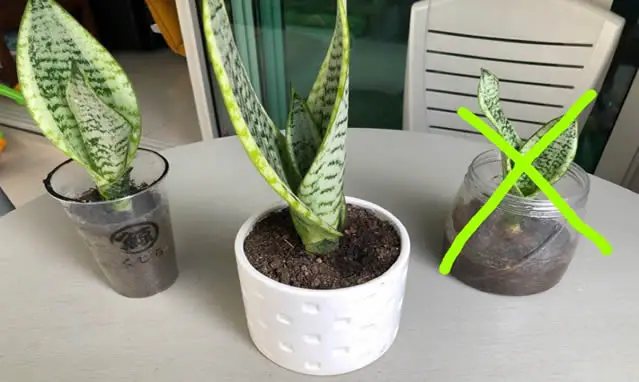
Creating Your Own Soil Mix
Crafting a custom soil mix for your snake plant is straightforward and allows you to tailor it to your plant’s needs.
Here’s a simple recipe:
1 part potting mix or peat moss: Serves as the base, offering structure and some moisture retention.
1 part perlite or coarse sand: Enhances drainage, preventing waterlogged conditions that can lead to root rot.
1 part succulent or cactus mix: Provides additional aeration and ensures the mix is well-draining.
Mix these components thoroughly to create a uniform blend. Before potting, test the mix by watering it; the water should drain quickly, indicating good drainage.
Choosing The Correct Store-Bought Soil
If you prefer purchasing ready-made soil, look for mixes labeled as “succulent” or “cactus” soil.
These are formulated for excellent drainage, which is crucial for snake plants. Avoid soils with excessive peat moss or compost, as they can retain too much moisture.
To further enhance drainage, consider adding coarse sand or perlite to the mix.
Additional Tips
Pot Selection
Use pots with ample drainage holes.
Terracotta pots are excellent choices, as they allow the soil to dry more evenly.
Repotting
Repot your snake plant every 2-3 years or when it becomes root-bound.
This is also a good time to refresh the soil mix.
By providing the right soil mix and following these care tips, your snake plant will flourish, adding beauty and clean air to your home.
Understanding Snake Plant Humidity Needs
One of the standout features of snake plants is their ability to thrive in a variety of conditions, including fluctuating humidity levels.
Ideal Humidity Range
While snake plants are tolerant of different humidity levels, they flourish best in environments with a relative humidity between 40% and 60%.
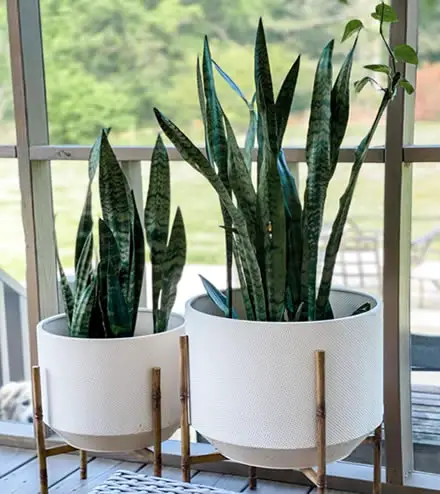
This range supports healthy transpiration and overall plant vigor.
Managing Low Humidity
In homes with lower humidity, especially during winter months, snake plants can still thrive.
Their drought-tolerant nature means they don’t require additional humidity.
However, if you notice the leaf tips turning brown or curling, it might be a sign of low humidity.
In such cases, consider grouping your plants together to create a microenvironment with higher humidity or using a humidifier to boost moisture levels.
Avoiding Excessive Humidity
While snake plants can tolerate a range of humidity levels, they are not suited for extremely humid conditions.
High humidity can lead to issues like root rot, especially if combined with overwatering.
Ensure your plant’s pot has proper drainage and avoid letting it sit in water.
Fertilizing Your Snake Plant: A Simple Guide
While snake plants are not heavy feeders, providing them with the right nutrients can boost their growth and overall health.
Choosing the Right Fertilizer
For snake plants, a balanced, all-purpose liquid fertilizer with an NPK ratio of 10-10-10, like this one, is ideal.
This ensures your plant receives essential nutrients for robust growth.
Liquid fertilizers are particularly convenient because they can be easily diluted, reducing the risk of over-fertilization.
How to Fertilize
- Dilute the Fertilizer: Mix the liquid fertilizer with water according to the package instructions. To be cautious, you might choose to dilute it to half strength.
- Apply During Growing Season: Fertilize your snake plant every 4-6 weeks during the active growing season, typically spring and summer. Avoid fertilizing in the winter when the plant is dormant.
- Watering: Before applying fertilizer, ensure the soil is moist. This helps prevent root burn.
- Application: Pour the diluted fertilizer into the soil, ensuring it reaches the root zone. Avoid getting fertilizer on the leaves to prevent potential damage.
Potting and Repotting Your Snake Plant
To keep them thriving, it’s essential to provide the right potting conditions for your snake plants and you need to know when and how to repot them.
Choosing the Right Pot
Selecting an appropriate pot is crucial for your snake plant’s health. Opt for containers with ample drainage holes to prevent water accumulation, which can lead to root rot.
As I mentioned previously, terracotta pots are excellent choices, as they allow the soil to dry more evenly.
Ensure the pot is only slightly larger than the current root ball to prevent overwatering.
Ideal Soil Mix
Snake plants thrive in well-draining soil. A mix designed for succulents or cacti is ideal.
Alternatively, you can create your own by combining equal parts of potting soil, perlite, and coarse sand (see relevant section above).
This blend ensures proper aeration and drainage, promoting healthy root development.
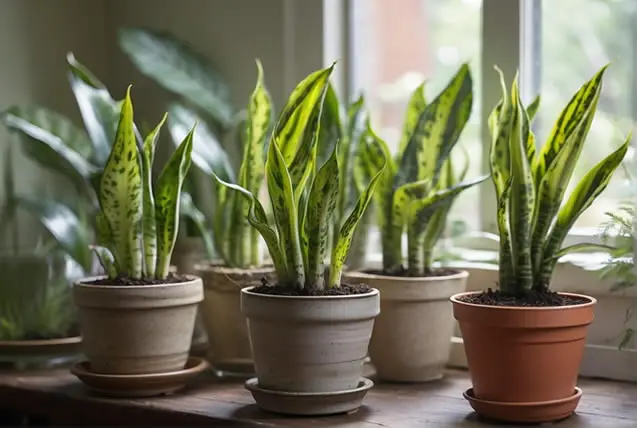
When to Repot
Snake plants typically need repotting every 3 to 4 years.
The best time to repot is during the plant’s active growing season, usually in late winter or early spring.
Signs that your snake plant needs repotting include roots growing out of the drainage holes, the plant becoming top-heavy, or the soil drying out too quickly.
How to Repot
- Prepare the New Pot: Place a layer of the well-draining soil mix at the bottom of the new pot.
- Remove the Plant: Gently turn the current pot on its side and carefully remove the plant, supporting the base to avoid damaging the leaves.
- Inspect the Roots: Examine the root ball, trimming any dead or damaged roots with sterilized scissors.
- Place in New Pot: Position the plant in the center of the new pot, ensuring it’s at the same soil level as before.
- Fill with Soil: Add the prepared soil mix around the root ball, pressing gently to eliminate air pockets.
- Water: Water the plant thoroughly, allowing excess water to drain.
- Post-Repotting Care: Place the repotted snake plant in a location with bright, indirect sunlight and resume regular watering once the top inch of soil feels dry.
By following these steps, you can ensure your snake plant continues to thrive in its new environment.
Keeping Your Snake Plant Clean and Healthy
Snake plants, or Sansevieria, are known for their hardiness and air-purifying qualities.
Regular cleaning not only enhances their appearance but also ensures they continue to thrive.
Why Cleaning Matters
Dust accumulation on snake plant leaves can obstruct sunlight absorption, hindering photosynthesis and overall plant health.
Additionally, dust can attract pests and reduce the plant’s ability to purify the air effectively.
How to Clean Your Snake Plant
- Dusting: Use a microfiber cloth or a damp paper towel to gently wipe both sides of each leaf. This method is effective for removing dust without causing damage.
- Showering: For a more thorough cleaning, place the plant in the bathtub or shower and gently rinse the leaves with lukewarm water. Ensure the soil is covered to prevent overwatering. After rinsing, allow the plant to drain completely before returning it to its spot.
- Leaf Care: After cleaning, inspect the leaves for any signs of pests or damage. Regular cleaning provides an opportunity to monitor your plant’s health closely.
Additional Tips
- Frequency: Dust your snake plant every few weeks to maintain its health and appearance.
- Avoid Harsh Chemicals: Refrain from using leaf shine products or harsh chemicals, as they can damage the leaves.
- Proper Drainage: When rinsing the plant, ensure the pot has adequate drainage to prevent waterlogging.
By incorporating regular cleaning into your snake plant care routine, you’ll help your plant stay healthy and vibrant.

